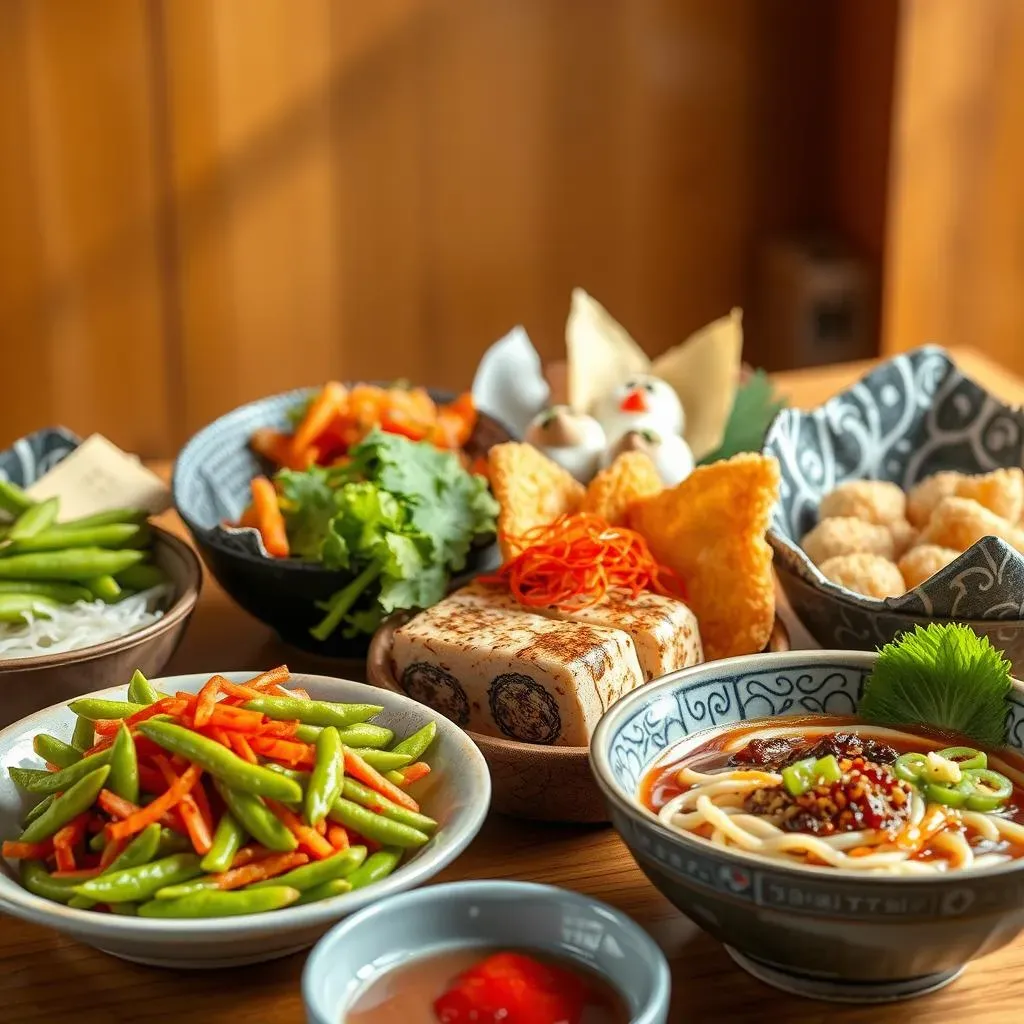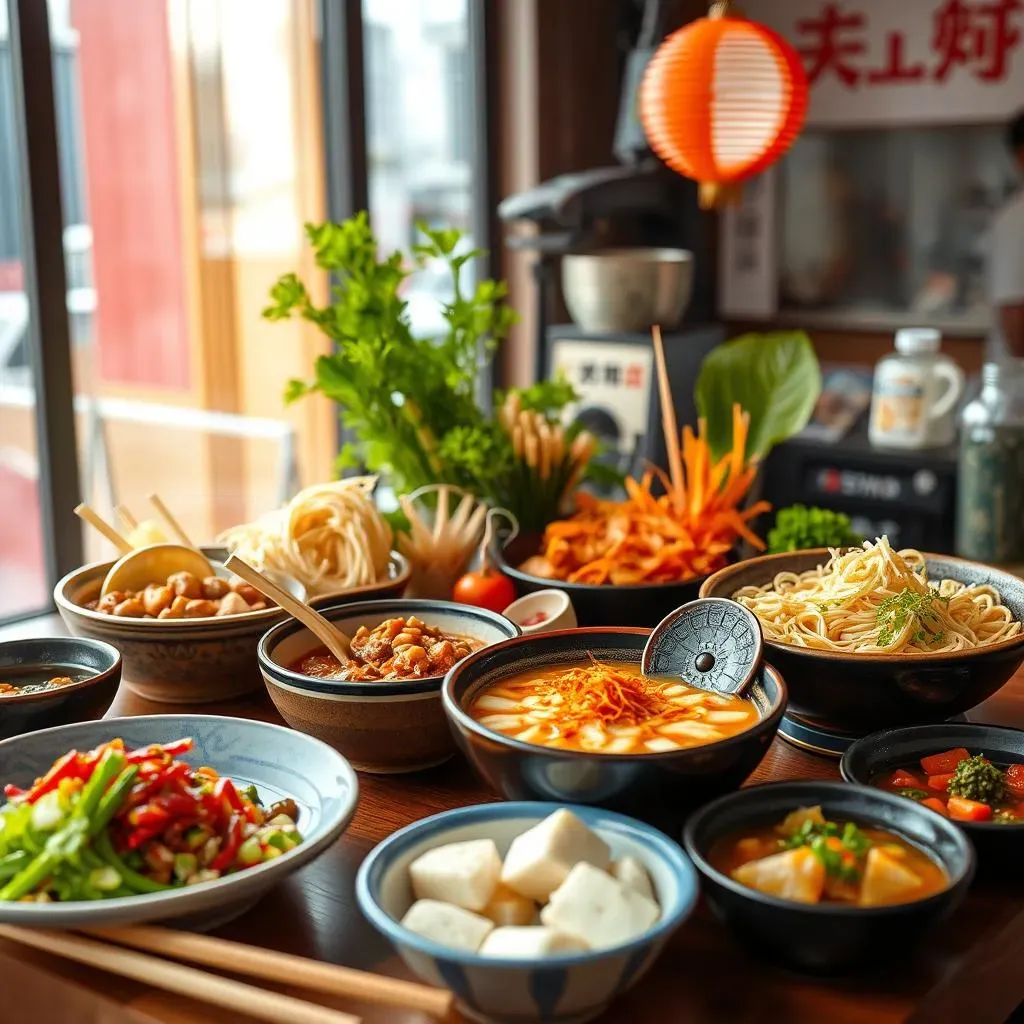Table of Contents
So, you're dreaming of Japan, land of stunning temples, bustling cities, and… well, maybe not the most obvious place for vegetarians, right? I get it. I've been there, staring at menus full of unidentifiable ingredients, wondering if "dashi" is just a fancy word for fish broth. But fear not, fellow plant-eaters! Japan isn't a culinary dead zone for us. In fact, with a little know-how, you can discover some seriously amazing vegetarian Japanese food. This guide is your key to unlocking the tasty secrets of Japan. We will navigate the sometimes tricky world of Japanese cuisine, looking at dishes that are naturally vegetarian or can easily be adapted. We'll explore the best vegetarian tofu dishes, and of course, I'll share my personal list of the best vegetarian Japanese restaurant finds across the country. Get ready to say "itadakimasu" to a whole new world of flavor!
Navigating Japan as a Vegetarian: Tips and Tricks
Navigating Japan as a Vegetarian: Tips and Tricks
The Language Barrier: Your First Hurdle
let's be real, the first thing that hits you when you're a vegetarian in Japan is the language. It's not just about saying "hello" and "thank you." You need to be able to explain your dietary needs. I remember my first trip, I thought simply saying "I don't eat meat" would be enough. Boy, was I wrong! Turns out, fish broth is everywhere, even in things you wouldn't suspect, like miso soup. So, learning a few key phrases is crucial. "Watashi wa bejitarian desu" (I am a vegetarian) is a good start, but it's not a magic bullet. You'll often need to be more specific about what you can and can't eat.
Think of it like this: you wouldn't go to a car mechanic and just say "fix my car," right? You'd probably say "my tires are flat" or "my engine is making a weird noise." The same goes for food in Japan. "Niku wa tabemasen" (I don't eat meat) is useful, but also learn "sakana wa tabemasen" (I don't eat fish) and "dashi wa dame desu" (no fish broth). It might seem like a lot, but trust me, it's worth the effort. You might even want to create a little card with these phrases, or use a translation app. It's like having a vegetarian shield that will help you avoid those surprise fishy flavors.
Tools of the Trade: Apps and Cards
Speaking of apps and cards, these are your best friends in Japan. Forget trying to gesture your way through a complicated dietary restriction. A good translation app is a lifesaver. I use one that allows me to scan menus and translate them on the fly. It's not always perfect, but it's a heck of a lot better than guessing. Also, consider preparing a digital or printed card. This card should clearly state, in Japanese, what you can and cannot eat. You can even include pictures of meat, fish, and other things you want to avoid. It's a bit like having a visual menu for your dietary needs. This way, you can avoid those awkward moments where you're trying to explain "no fish" while the waiter is looking at you like you've just asked for a unicorn.
I once had a waiter in a small ramen shop look utterly bewildered when I tried to explain my dietary needs. I whipped out my card, and his face immediately lit up. He pointed to a specific dish on the menu, confirming it was vegetarian. It was a total game changer. So, don't underestimate the power of preparation. These little tools can save you a lot of time, frustration, and potential fishy encounters. It’s like having a secret weapon in your culinary arsenal. Just remember to keep your phone charged and your card handy. You never know when you might need them.
Tool | Description | Why it's Useful |
|---|---|---|
Translation App | App that translates languages | Helps understand menus and communicate needs. |
Dietary Card (Digital or Printed) | A card with your dietary restrictions in Japanese | Clearly communicates your needs to staff. |
Delicious Vegetarian Japanese Food to Try
Delicious Vegetarian Japanese Food to Try
Naturally Vegetarian Delights
Alright, so you've got your phrases down and your translation app ready. Now, let's get to the good stuff: the food! Japan actually has a bunch of dishes that are naturally vegetarian. Think about edamame, those little green soybeans are a perfect snack, lightly salted and totally addictive. You can find them everywhere, from convenience stores to fancy restaurants. Another great option is agedashi tofu, which is deep-fried tofu served in a savory broth. Make sure you double check the broth to confirm it is vegetarian. It's crispy on the outside, soft on the inside, and just plain delicious. And who can forget about onigiri? These rice balls are a staple in Japan and you can find many vegetarian versions – just be sure to check the fillings! Umeboshi (pickled plum) and kombu (seaweed) are great options. It's like a little portable meal that's perfect for a quick bite.
Don't forget about the noodles! Soba noodles, made from buckwheat, are often served cold with a dipping sauce or in a hot broth. The key is to specify no fish broth, and you're good to go. You can also find vegetarian versions of udon noodles. These thick, chewy noodles are super satisfying. And for a light and refreshing dish, try hiyayakko, a chilled tofu dish topped with soy sauce, ginger, and scallions. It’s simple, yet incredibly flavorful. It's like a refreshing burst of coolness on a hot day. These are just a few examples, and there are plenty more vegetarian delights waiting to be discovered. It's all about knowing what to look for and not being afraid to ask questions. It's an adventure for your taste buds!
Veggie-Adaptable Dishes
so not everything is automatically vegetarian in Japan, but many dishes can be easily adapted. Take tempura for instance. While traditionally, tempura includes seafood, you can easily order a veggie version with seasonal vegetables like sweet potato, eggplant, and pumpkin. Just make sure to request it without any fish-based batter or dipping sauce. Okonomiyaki, a savory pancake, is another dish that can be made vegetarian. The base is usually a batter and cabbage, and you can add other veggies like carrots or mushrooms. Just confirm that it’s not cooked on a grill that had meat previously. It's like a customizable culinary canvas, where you can create your own veggie masterpiece.
And let's talk about curry. Japanese curry is super popular, and while many versions include meat, you can find vegetarian options with potatoes, carrots, and other vegetables. Just ask about the ingredients, and you might be surprised by how many places offer a veggie-friendly curry. Also, don't forget about pickles! Japanese pickles, or tsukemono, are a great side dish and come in all sorts of flavors. From salty to sweet to sour, they add a nice kick to any meal. It's like a flavor explosion in every bite. With a little bit of flexibility and a willingness to ask questions, you can find so many delicious and satisfying vegetarian options. It's all about being open to new experiences and not being afraid to step outside of your culinary comfort zone.
Dish | Description | Vegetarian Notes |
|---|---|---|
Edamame | Steamed soybeans | Naturally vegetarian |
Agedashi Tofu | Deep-fried tofu in broth | Ensure broth is vegetarian |
Onigiri | Rice balls with fillings | Choose vegetarian fillings like umeboshi or kombu |
Soba/Udon Noodles | Buckwheat/wheat noodles | Specify no fish broth |
Tempura | Deep-fried battered vegetables | Request veggie version |
Okonomiyaki | Savory pancake | Ask for veggie ingredients |
Our Top Picks for the Best Vegetarian Japanese Restaurants
Our Top Picks for the Best Vegetarian Japanese Restaurants
Tokyo's Vegetarian Gems
so you've navigated the language, you know your edamame from your agedashi tofu, now it's time for the real deal: restaurants! Tokyo, being the mega-city it is, has some truly amazing vegetarian options. First up, let's talk about "Ain Soph Journey." This place is like a vegetarian haven. They have multiple locations across Tokyo and Kyoto, and their food is just beautiful. Think elegant plates of vegan ramen, fluffy pancakes, and decadent desserts. It’s not just food, it’s an experience. The atmosphere is relaxed, and the service is top-notch. It’s the type of place where you can take your time, savor every bite, and feel like you’re treating yourself to something special. It’s definitely a must-try if you’re in the city. I remember my first visit there, I ordered a vegan burger that was so good I almost cried. maybe not cried, but I was definitely very, very happy.
Another spot that deserves a shout-out is "T's Tantan." This restaurant is all about vegan ramen, and they absolutely nail it. They have a wide variety of broths, toppings, and noodle types, so there’s something for everyone. The flavors are rich, the noodles are perfectly cooked, and the portions are generous. It's the perfect place to warm up on a chilly day or just satisfy a serious ramen craving. It’s also super convenient as they have a location in Tokyo station! Trust me, you won’t miss the meat at all. I once brought a friend who was a self-proclaimed meat lover, and even he was blown away by the taste and texture. He was like, "Wait, this is vegan?!" It’s that good.
Kyoto's Culinary Delights
Now, let’s hop over to Kyoto, the cultural heart of Japan. Kyoto is known for its traditional cuisine, and thankfully, that includes some amazing vegetarian options. Shojin ryori, a traditional Buddhist cuisine, is completely vegan and can be found in temples and some restaurants. It’s a very different experience from your regular restaurant meal. It’s all about simplicity, seasonality, and respect for the ingredients. Think delicate dishes of tofu, vegetables, and wild plants. It’s like a culinary meditation, where every bite is a moment of mindfulness. I’ve tried shojin ryori at several temples in Kyoto, and every time, I’m amazed by the depth of flavor and the artistry of the preparation. It's a real cultural experience, not just a meal. It's like stepping back in time and experiencing a centuries-old tradition.
But if you’re looking for something a bit more modern, check out "Yoshiya Restaurant". This place is a gem. It’s a family-run restaurant that serves up delicious vegetarian and vegan versions of traditional Japanese dishes. They are super friendly and accommodating, and they clearly know their stuff. I remember ordering a vegetarian set meal there, and every dish was bursting with flavor. They use fresh, local ingredients, and you can really taste the difference. It’s the kind of place where you feel like you’re being welcomed into someone’s home. It’s cozy, charming, and absolutely delicious. They even gave me a little lesson on how to properly use chopsticks! It’s those small touches that make a restaurant truly special.
Restaurant | City | Cuisine | Why it's great |
|---|---|---|---|
Ain Soph Journey | Tokyo & Kyoto | Vegan comfort food | Elegant dishes, relaxed atmosphere |
T's Tantan | Tokyo | Vegan ramen | Wide variety of broths and toppings |
Shojin Ryori (various temples) | Kyoto | Traditional Buddhist cuisine | Simple, seasonal, and mindful |
Yoshiya Restaurant | Kyoto | Vegetarian Japanese | Family-run, fresh ingredients |
Wrapping Up Your Vegetarian Adventure in Japan
Exploring Japan as a vegetarian might seem like a challenge at first, but it's totally doable, and honestly, incredibly rewarding. From the delicate flavors of shojin ryori to the hearty satisfaction of a veggie-packed okonomiyaki, there's a whole world of deliciousness waiting to be discovered. Remember to be patient, be curious, and don't be afraid to ask questions. With a little planning and a sense of adventure, you can have an amazing culinary experience in Japan, proving that plant-based eating can be just as exciting, if not more so, than the traditional options. So go on, book that flight, pack your appetite, and get ready to find your new favorite best vegetarian Japanese restaurant. Happy eating!